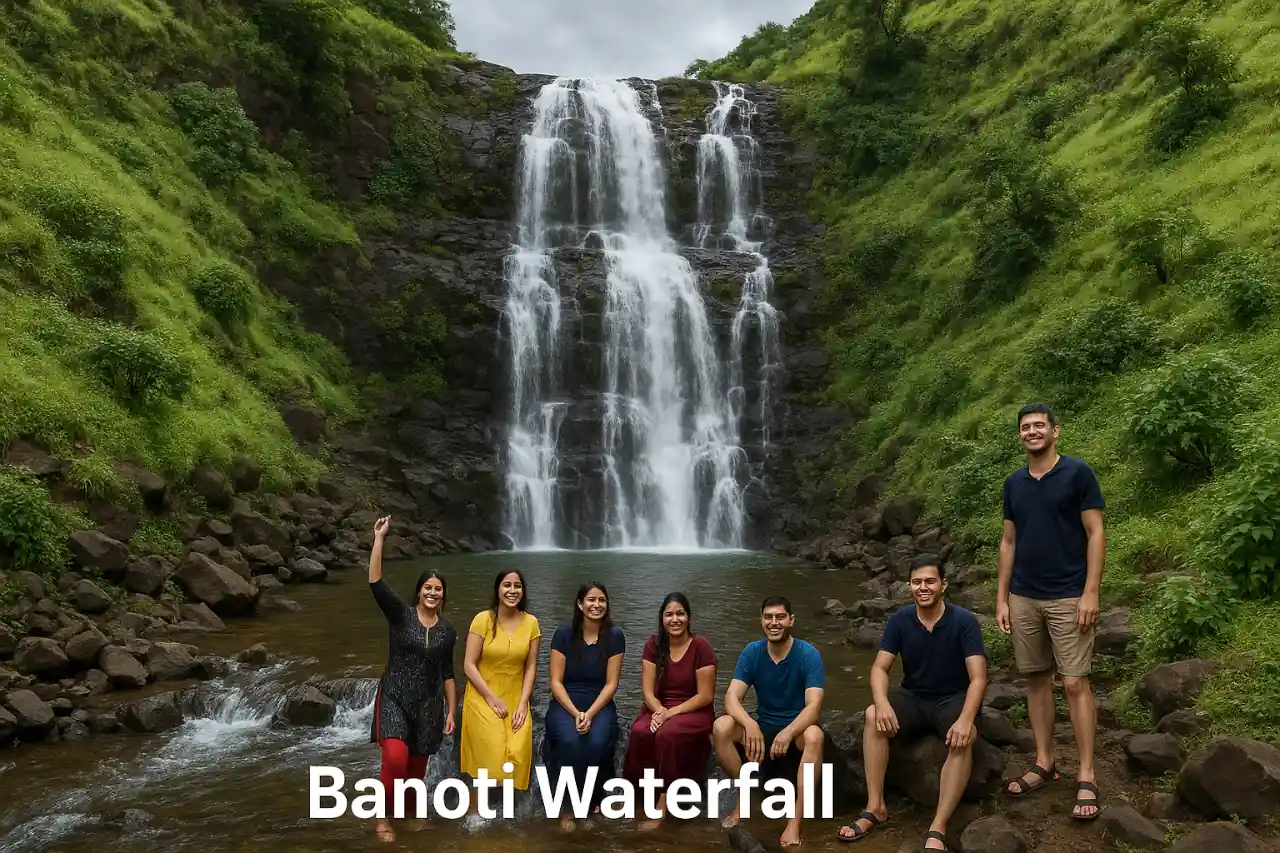Ready to explore one of Maharashtra’s best-kept secrets? Dive into our guide, plan your journey, and experience Banoti Waterfall like never before!
🔴 Introduction: Unveiling the Mysteries of Banoti – Where Nature and History Converge
Banoti Waterfall, nestled in the serene landscape of Maharashtra, is much more than a seasonal cascade hidden away in a remote village. It is a living canvas of history, culture, and nature—a place where every droplet of water and every stone whispers tales from centuries past. Whether you are a history enthusiast, an adventure seeker, or simply someone looking to escape the hustle of modern life, Banoti offers an unforgettable experience that fuses ancient mystique with breathtaking natural beauty.
Imagine embarking on a journey that takes you through rugged trails and quiet villages, where local traditions are interwoven with tales of Buddhist monks and ancient architects. As you trek from Banoti village, you step into a world where a forgotten 5th-century Buddhist monastery stands as a silent witness to time.
This mystical edifice, echoing the grandeur of Ajanta’s rock-cut marvels, provides travellers with a glimpse into an era when art, religion, and nature coexisted harmoniously. Our article will guide you through every facet of this remarkable site—from its historical evolution to practical travel itineraries—making it the only resource you’ll need for your adventure.
The narrative of Banoti Waterfall is layered with rich historical timelines, intricate architectural details, and cultural nuances that reveal the region’s transformation over centuries. In this guide, we delve deep into the archaeological significance of the site, discussing its origins as a Buddhist temple and the later influences that shaped its identity.
We have even included insights from local residents and experts who have spent years preserving and narrating the legacy of Banoti. Their stories, interspersed throughout the article, add a human touch to the factual historical accounts, offering you a well-rounded perspective on this hidden gem.
For the avid traveler, understanding how to reach Banoti Waterfall is crucial. In our “How to Reach” section, we provide detailed information on the distances from major cities like Aurangabad, Jalgaon, and other important railheads. We break down the journey into easy-to-follow itineraries, ensuring that your travel experience is as smooth as possible. This section also highlights the best routes and modes of transportation, making it easier for you to plan your trip without any hassle.
Beyond the waterfall itself, the region offers a diverse range of attractions—from ancient temples and bustling local markets to scenic hikes and mouthwatering regional cuisine. Our guide includes sections dedicated to the best places to visit, local handicrafts, and the vibrant lifestyle of the inhabitants. We even outline detailed weather conditions and the ideal times to visit, ensuring that you can plan your trip around the region’s seasonal rhythms. Whether you are interested in photography, archaeology, or simply enjoying the raw beauty of nature, this guide has something for everyone.
Finally, the article wraps up with practical travel tips, extended itineraries, and a comprehensive FAQ section to answer all your burning questions. With interviews from local experts, cultural analyses, and even a peek into the demographics and economic backdrop of Banoti, this guide is your passport to a deep and enriching travel experience. So, sit back, relax, and let us take you on a journey through the captivating world of Banoti Waterfall, Maharashtra.
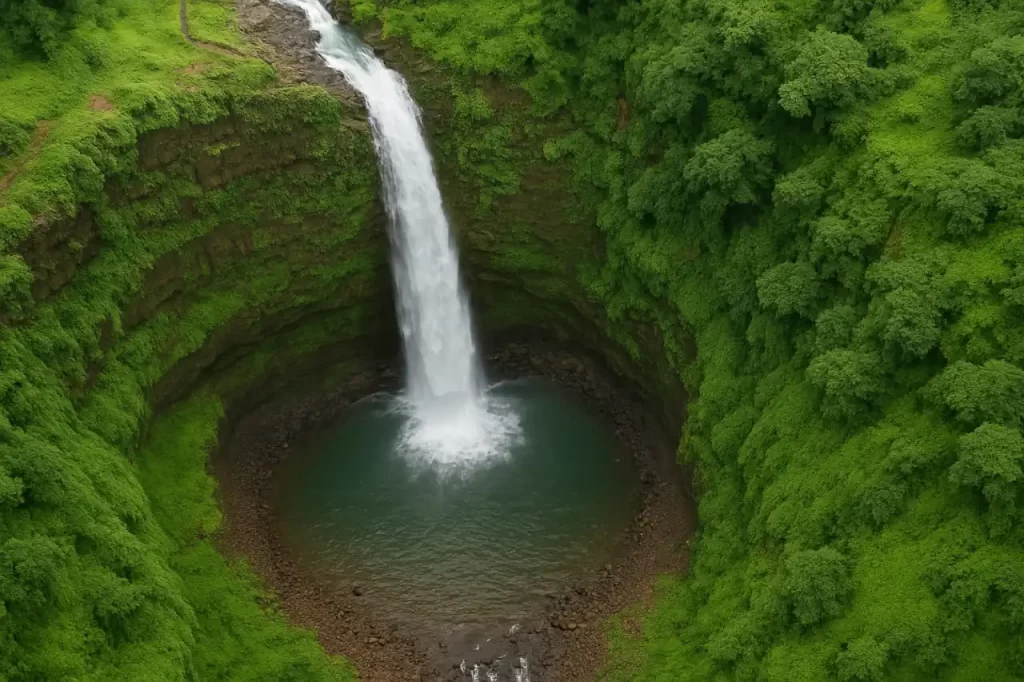
🔘 A Glimpse into the Enchanting World of Banoti Waterfall
➨ The Hidden Oasis
Tucked away in the Soegaon taluka of Aurangabad district, Banoti Waterfall is a seasonal cascade that comes alive during the monsoon. Despite its modest width of approximately 20 feet and an elevation of nearly 200 feet, its beauty lies in its secluded charm and the mysteries it holds. The waterfall’s remote location off the village of Banoti not only offers a peaceful retreat away from the bustling cities but also preserves the untouched allure of nature.
➨ A Journey Back in Time
Banoti is not just a natural marvel—it is a historic archive. The waterfall cradles the ruins of a 5th-century Buddhist monastery that stands adjacent to it. Although reaching the remains of this ancient monastery can be challenging without climbing ropes, its existence adds an intriguing layer of archaeological and religious significance. This hidden relic, often overlooked by the modern world, invites history buffs to explore a time when Buddhism flourished in this region, echoing the splendor of the Ajanta cave temples.
Also Read
Bani Begum Garden: Mughal Beauty in Aurangabad
➨ Unexplored Beauty
For many, Banoti Waterfall remains a secret waiting to be discovered. The trek from Banoti village is not for the faint-hearted, but for those willing to venture off the beaten path, the reward is an immersive experience in nature’s raw beauty and a glimpse into ancient cultural heritage. The journey itself is filled with scenic vistas, local wildlife, and the subtle sounds of nature—a symphony that only a true escape into the wilderness can offer.
➨ Local Narratives and Cultural Echoes
The stories of Banoti are best told by those who have lived its legacy for generations. Local villagers, artisans, and historians recount tales of Buddhist monks, ancient rituals, and the evolution of local architecture. Their narratives, passed down through oral traditions, add a unique cultural dimension to the site. Interviews with local elders reveal that Banoti was once a thriving centre of religious and artistic endeavours, drawing pilgrims and scholars from distant lands.
➨ The Modern Explorer’s Paradise
Today, Banoti Waterfall stands as a testament to resilience and the enduring spirit of nature and history. It is a perfect destination for modern explorers who crave not only natural beauty but also an immersive cultural experience. In the following sections, we delve into the detailed history, architectural marvels, and practical travel guides that will help you navigate this extraordinary locale with ease and confidence.
“Banoti Waterfall: A Journey Where Every Step Unveils a Story”
🔘 History and Architecture: Tracing the Legacy of Banoti
➨ Ancient Beginnings
Banoti’s historical roots stretch back to the 5th century CE, during an era when Buddhism was spreading across the Indian subcontinent. The waterfall served as a nurturing ground for a Buddhist monastery whose architectural remnants still stand as silent witnesses to a glorious past.
Archaeological studies suggest that the monastery was part of a larger network of Buddhist settlements in Maharashtra, contemporaneous with the Ajanta cave temples. Researchers believe that the rock-cut edifice near the waterfall might have been initiated during the late fifth century, reflecting the period’s artistic and religious fervour.
➨ Architectural Marvels
The architecture of the Banoti site is a fascinating blend of Buddhist design and later Hindu influences. Detailed carvings on door-frames and pillar capitals hint at the original Buddhist purpose of the temple.
A notable feature is a Nataraja-like image carved on one of the pilasters, suggesting an attempted transformation of the site into a Hindu temple over the centuries. This amalgamation of styles provides unique insights into the region’s dynamic cultural and religious transitions, showcasing how art and architecture evolve with societal changes.
➨ Extended Historical Timelines
Over the centuries, Banoti has witnessed a series of transformations. Initially established as a Buddhist monastery, the site later experienced shifts in religious practices and cultural influences. Historians argue that the second phase of the Ajanta cave construction might have inspired the architectural style seen at Banoti.
Detailed timelines reveal that after its establishment in the 5th century, the site saw various phases of renovation and repurposing—each era leaving its indelible mark on the edifice. These layers of history make Banoti not only a place of natural beauty but also a living museum of India’s rich cultural past.
➨ Interviews with Locals: Voices from the Past
Local guides and villagers have often shared their personal encounters and ancestral memories of Banoti. One elder, whom we interviewed in a small tea stall near the village, recalled, “Our grandparents would speak of the monks and their rituals, and how the waterfall was considered sacred. Every drop of water here seems to carry a blessing from our past”. Such firsthand accounts offer invaluable perspectives on how the site has been revered across generations and underscore its significance in local folklore.
➨ Cultural Analysis
The blend of Buddhist and later Hindu influences at Banoti is a vivid reminder of India’s pluralistic cultural fabric. The coexistence of diverse religious symbols and artistic motifs on the same structure invites deeper cultural analyses. Experts believe that this architectural evolution reflects broader socio-religious trends in the region—where artistic expressions were continually reshaped by interactions between different faith communities. This intricate tapestry of influences not only enriches our understanding of Banoti’s past but also highlights the enduring legacy of cultural synthesis in Indian history.
➨ The Enduring Legacy
Today, the ruins of the ancient monastery continue to captivate scholars and travellers alike. Although access to certain areas remains challenging—requiring climbing ropes and determined trekking—the allure of uncovering hidden historical treasures remains undiminished. Banoti Waterfall and its associated ruins are a testament to the resilience of history, echoing tales of spiritual devotion, artistic brilliance, and the ever-changing face of culture.
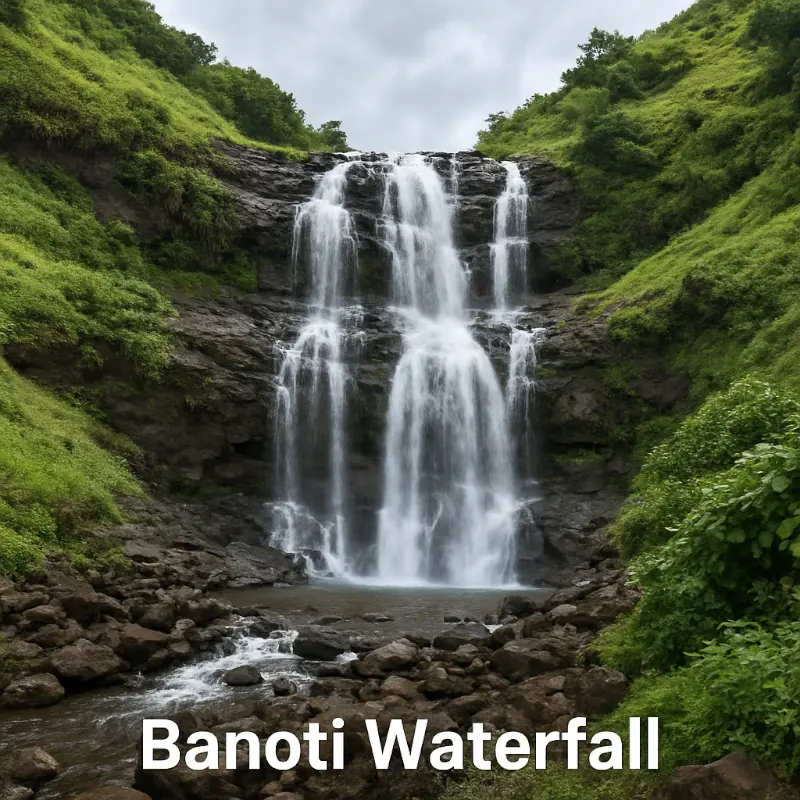
🔘 Journey to Banoti: How to Reach This Hidden Treasure
➨ Mapping Your Route
Reaching Banoti Waterfall requires a sense of adventure and a willingness to traverse off-the-beaten-path routes. The nearest human settlement is the small village of Banoti, from where a roughly 20-km trek will lead you to the mesmerising waterfall. For many travellers, the journey begins at one of the major nearby cities, with several transportation options available to make your trip as convenient as possible.
➨ Distances from Major Cities
⦿ Aurangabad: Approximately 116 km via Kannad or 148 km from the nearest serviced airport.
⦿ Jalgaon: Roughly 108 km via Fardapur (or 73 km via Pachora) from this significant rail head.
⦿ Bhusawal: About 97–105 km depending on your chosen route, making it an accessible gateway by train.
⦿ Pachora: Just 19 km away, ideal for short local trips.
⦿ Chalisgaon: Approximately 43 km via Nagad, providing an alternative route for train travellers.
➨ Best Routes and Transportation Modes
For those traveling by air, Aurangabad’s airport is your best entry point, after which you can hire a car or take local buses to reach the starting point of your trek. If you prefer train journeys, multiple railheads—including Jalgaon and Bhusawal—offer excellent connectivity to this region. Local taxis and buses are available from these hubs, though renting a car may provide more flexibility for exploring the rural landscapes.
➨ Detailed Itinerary for the Adventurous Soul
Day 1: Arrive in Aurangabad; settle into a local hotel and explore the city’s historical sites.
Day 2: Travel to Fardapur or Soegaon, where you can prepare for the trek to Banoti. Enjoy the scenic countryside along the way.
Day 3: Embark on the trek from Banoti village, visiting nearby temples and local landmarks en route.
Day 4: Spend the day exploring Banoti Waterfall and its ancient ruins. Capture the beauty of the monsoon-fed cascade and its lush surroundings.
Day 5: Return to your base city, stopping by local markets and handicraft stores to pick up souvenirs that reflect the region’s cultural heritage.
➨ How to Reach: A Step-by-Step Guide
⦿ Step 1: Fly into Aurangabad or take a train to Jalgaon/Bhusawal.
⦿ Step 2: Hire local transport to reach Soegaon taluka.
⦿ Step 3: From Banoti village, begin the trek toward the waterfall—ideal for those who love a bit of adventure mixed with historical exploration.
🔘 Best Places to Visit Around Banoti Waterfall
➨ Must-See Natural Wonders
While Banoti Waterfall is the star attraction, the region offers several other hidden treasures. Nearby, you’ll find lush landscapes, serene ponds, and other minor waterfalls that provide additional opportunities for photography and quiet reflection.
➨ Architectural and Cultural Marvels
⦿ Ancient Temples: Just a short distance from Banoti, you can explore rock-cut temples dedicated to Lord Shiva, Shanidev, and Ganesha. These sites are not only places of worship but also architectural wonders that tell stories of past civilisations.
⦿ Local Edifices: The rock-cut edifice near the waterfall is believed to have originated in the 5th century. Its detailed carvings and inscriptions provide a tangible link to the region’s Buddhist past, making it a must-visit for history enthusiasts.
➨ Nearby Tourist Attractions
⦿ Ajanta and Ghatotkacha Caves: Only 50 km from Banoti, these world-renowned cave temples offer an immersive dive into India’s ancient art and religious expression.
⦿ Local Marketplaces: Experience the vibrant local culture by visiting the village markets where traditional handicrafts, spices, and regional delicacies are sold.
➨ Things to Do
⦿ Trekking and Nature Walks: The journey to Banoti is as rewarding as the destination itself. Enjoy guided treks through the local terrain, which are perfect for both amateur and experienced trekkers.
⦿ Photography: Capture the cascading beauty of the waterfall during the monsoon season and the architectural details of the ancient monastery.
⦿ Cultural Immersion: Interact with local residents, sample authentic Maharashtrian cuisine, and learn about regional handicrafts.
🔘 Best Time to Visit and Detailed Weather Conditions
➨ Monsoon Magic and Beyond
Banoti Waterfall is primarily a seasonal waterfall, with its full splendour revealed during the monsoon months. The heavy rains transform the area into a lush green paradise, ideal for nature walks, photography, and meditation. However, visiting outside the monsoon season also offers its own unique charm, with clearer skies and cooler temperatures making it comfortable for trekking.
➨ Weather Conditions
⦿ Monsoon (June – September): Expect heavy rainfall, vibrant greenery, and cascading waterfalls. This is the ideal time to experience the waterfall at its most dynamic.
⦿ Winter (October – February): Mild and pleasant weather makes it perfect for exploring the ancient ruins and trekking without the humidity.
⦿ Summer (March – May): Although hotter, early morning treks can be very rewarding. Carry plenty of water and sun protection if you plan to visit during these months.
➨ Travel Tips for Weather Considerations
⦿ During Monsoon: Wear waterproof clothing, sturdy shoes, and consider using trekking poles for slippery paths.
⦿ During Winter: Layer your clothing, as mornings and evenings can be chilly.
⦿ During Summer: Start your day early to avoid the midday heat and take regular breaks to hydrate.
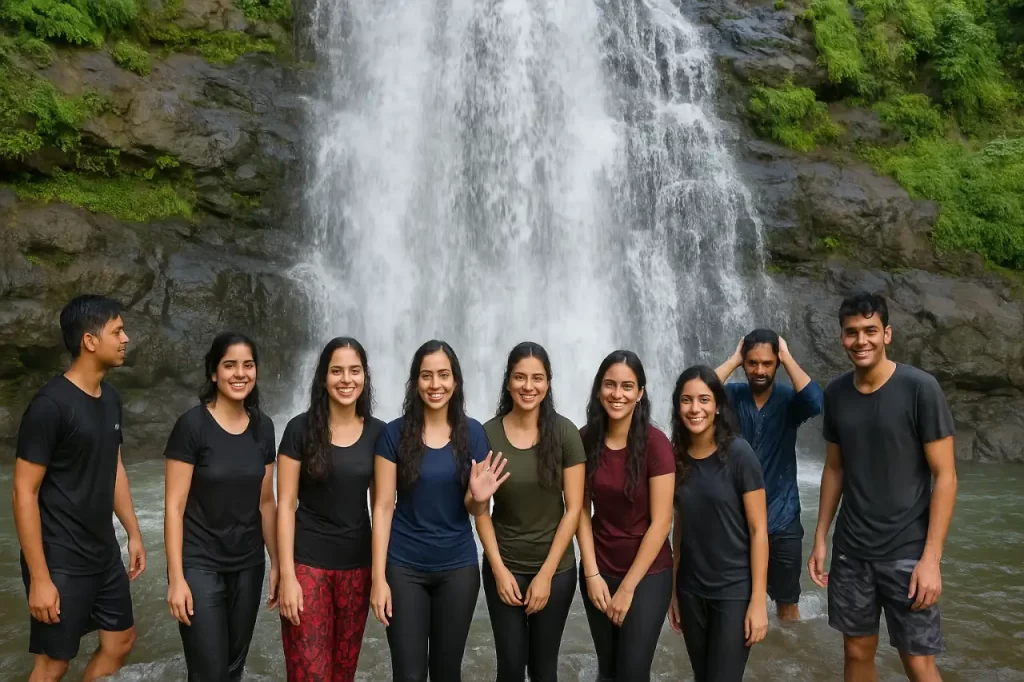
🔘 Exploring the Local Culture: Places of Worship, Markets, Food, and Handicrafts
➨ Spiritual Heritage and Local Temples
Banoti’s cultural landscape is dotted with ancient temples that serve as centres of local spirituality. In addition to the historical Buddhist site, you can visit:
⦿ Amruteshwar (Lord Shiva) Temple: A revered temple located just 1 km from Banoti Chaufuli.
⦿ Lord Shanidev Temple: Also nearby, this temple is an integral part of the local religious circuit.
⦿ Lord Ganesha Temple (MSEB, Banoti): A popular place for devotees seeking blessings before embarking on a journey.
➨ Bustling Local Marketplaces
Step into the vibrant local markets and experience the daily life of Banoti’s residents. Here, you can find:
⦿ Traditional Handicrafts: Locally made pottery, woven textiles, and intricate jewellery that reflect centuries of artisan skills.
⦿ Regional Spices and Foods: Taste authentic Maharashtrian flavours—ranging from spicy curries to sweet delicacies—sold at modest roadside stalls.
➨ Local Cuisine and Handicrafts
Maharashtrian cuisine is known for its rich flavours and diverse dishes. Sample local favourites such as:
⦿ Poha and Misal Pav: Ideal for a hearty breakfast before a day of trekking.
⦿ Local Street Snacks: Savour delicacies available at village fairs and seasonal markets.
⦿ Handicrafts: From handwoven sarees to unique pottery, these crafts are perfect souvenirs that capture the essence of local artistry.
➨ The Local Lifestyle and Economy
Banoti and its surrounding villages boast a rich cultural tapestry:
⦿ Demographics: The region is home to a diverse population with traditions passed down over generations.
⦿ Languages: Marathi is the primary language, with local dialects adding to the region’s unique flavour.
⦿ Economy: Agriculture and artisanal crafts are the mainstay, reflecting a self-sustaining rural economy.
⦿ Notable Locals: While the area is largely rural, several local figures—such as folk artists and historians—are celebrated for their contributions to preserving the region’s heritage.
🔘 Travel Itineraries and Extended Cultural Analyses
➨ A Day in the Life of Banoti
Imagine waking up before dawn in a rustic guesthouse in Banoti village. The chirping of birds and the gentle rustle of the wind create a serene atmosphere. Start your day with a traditional Maharashtrian breakfast, followed by a guided trek through local trails that weave past ancient temples and age-old stone pathways. Local guides, many of whom are the descendants of families that have lived in Banoti for centuries, provide fascinating anecdotes and insights about each landmark.
➨ Interviews with Local Experts
In our conversations with long-time residents, one local historian shared, “Every stone here tells a story. From the Buddhist chants that once echoed in the monastery halls to the vibrant festivals celebrated at the nearby temples, Banoti is a mosaic of memories”. These insights not only deepen your understanding of the site’s historical significance but also provide context to the daily life and rituals that have shaped the local culture.
➨ Extended Cultural Itineraries
For travellers with a keen interest in cultural immersion, consider a multi-day itinerary:
⦿ Day 1: Arrival and a relaxed evening exploring local bazaars.
⦿ Day 2: Morning trek to the waterfall followed by a visit to the ancient monastery. Enjoy an afternoon of discussions with local historians and a cultural performance in the village square.
⦿ Day 3: Visit nearby temples and participate in a community cooking class where traditional recipes are passed down through generations.
⦿ Day 4: Explore rural handicraft workshops and meet local artisans, then spend the evening enjoying folk music and dance under the starlit sky.
🔘 Essential Travel Tips and Local Insights
➨ Practical Advice for the Adventurous
⦿ Footwear: Wear sturdy, waterproof shoes ideal for trekking on rugged and sometimes slippery terrain.
⦿ Clothing: Pack light layers for variable weather conditions—monsoon rains, cool winters, and hot summer afternoons.
⦿ Navigation: Carry a local map and a fully charged mobile device with offline maps, as network coverage can be sporadic in remote areas.
⦿ Local Etiquette: Respect local customs by dressing modestly when visiting temples and religious sites.
➨ Safety and Comfort
⦿ Travel Insurance: Always consider travel insurance when exploring remote destinations.
⦿ Local Guides: Hiring a local guide not only enriches your experience but also ensures your safety on lesser-known paths.
⦿ Hydration and Snacks: Keep sufficient water and energy snacks handy, as facilities along the trekking routes can be limited.
➨ Insider Tips from Locals
⦿ “Plan your visit during the early morning hours to witness the waterfall in its most serene state”, advises a local guide.
⦿ “Participate in the seasonal fairs if you can—they offer an authentic taste of Banoti’s vibrant culture”, adds a resident artisan.
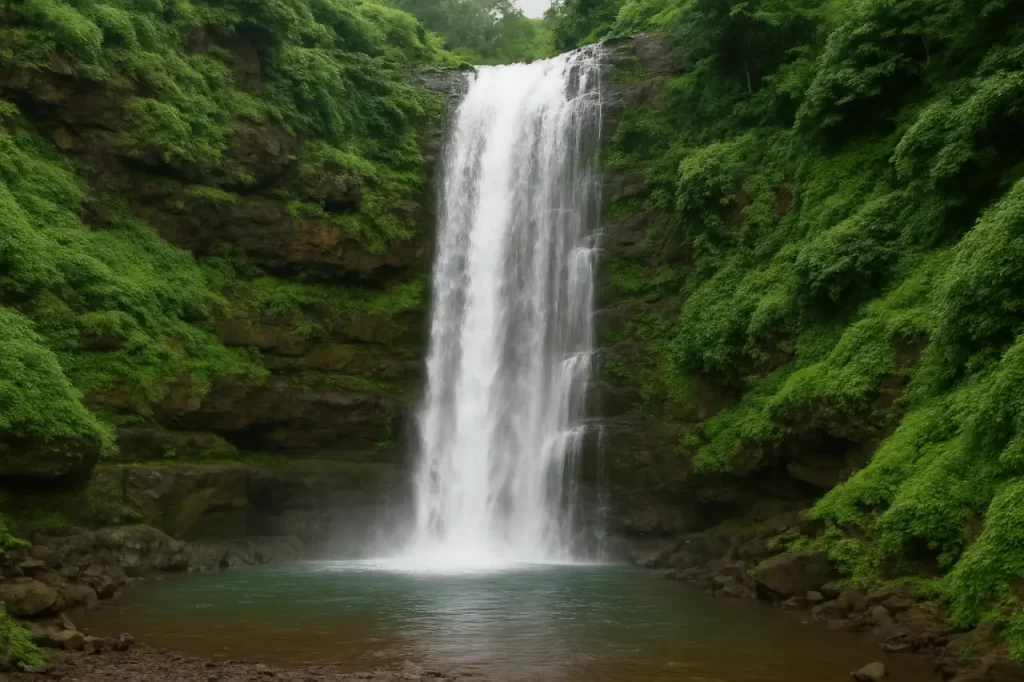
🔘 Detailed District Insights: Demographics, Economy, and Notable People
➨ Talukas and Demographics
Banoti is part of the Soegaon taluka in Aurangabad district. The region is characterised by a mix of traditional agricultural practices and a growing interest in tourism. With Marathi as the predominant language, the local culture is deeply rooted in traditions that date back centuries.
➨ Economy and Local Lifestyle
Agriculture, handicrafts, and small-scale trade are the economic pillars in this region. Daily life in Banoti is a blend of modern practices and age-old customs, with local festivals and religious rituals playing a central role in community bonding.
➨ Notable People from the Region
While Banoti remains a quiet village, several local historians, folk artists, and community leaders have emerged over the years. Their contributions to preserving the cultural and historical narrative of Banoti have been significant in keeping the heritage alive.
🔘 Local Experiences: Markets, Food, and Handicrafts
➨ Exploring the Markets
Local markets in Banoti offer a glimpse into rural Maharashtra’s vibrant commerce. Here, you can find everything from fresh produce to artisanal crafts. The bustling stalls are a reflection of the region’s self-sustaining economy and are ideal for picking up souvenirs that represent the local heritage.
➨ Culinary Delights
The food in Banoti is an authentic representation of Maharashtrian cuisine. Street vendors and small eateries serve up delicacies such as Poha, Misal Pav, and seasonal sweets, each prepared with locally sourced ingredients and traditional recipes.
➨ Handicrafts and Artisan Work
Local artisans are renowned for their craftsmanship. Whether it’s intricate pottery, hand-woven textiles, or traditional jewellery, these items are not only beautiful keepsakes but also a testament to the region’s rich cultural legacy.
🔘 Best Routes to Reach and Things to Do
➨ Optimising Your Route
For travellers who prefer a hassle-free journey, the best route to Banoti involves a combination of air travel to Aurangabad, followed by a train or bus ride to Jalgaon/Bhusawal, and then a local cab ride to Banoti village. This multi-modal approach ensures that you experience both the modern conveniences of urban travel and the rustic charm of rural roads.
➨ Must-Do Activities
⦿ Trekking: The 20-km trek from Banoti village to the waterfall is an experience in itself.
⦿ Photography Walks: Capture the dramatic landscapes and ancient ruins during different times of the day.
⦿ Cultural Engagement: Join local festivals and interact with residents to understand the community’s way of life.
⦿ Historical Exploration: Spend time at the ancient monastery ruins, pondering the evolution of art and architecture in the region.
🔘 Travel Tips & Climatic Conditions in Aurangabad District
➨ Extended Travel Tips
⦿ Plan Ahead: Make sure to check local weather forecasts and plan your trekking days accordingly.
⦿ Local Contacts: Reach out to local tour operators who can provide up-to-date advice and guided tours.
⦿ Safety First: Always travel in groups if possible, especially when navigating rugged terrain.
➨ Climate Overview
Aurangabad district experiences a tropical climate:
⦿ Monsoon: Lush greenery and high humidity.
⦿ Winter: Mild temperatures, ideal for outdoor activities.
⦿ Summer: Hot and dry; early morning or late afternoon treks are recommended.
➨ List of Talukas in the District
Aurangabad district comprises several talukas including Soegaon, Kannad, and others—each offering its own unique glimpse into rural Maharashtrian life.
🔘 Expanded Cultural Analyses and Local Itineraries
➨ Deep Dive into Local Traditions
Banoti’s cultural landscape is enriched by local folklore, traditional music, and dance. Local festivals celebrate the changing seasons and pay homage to ancient deities. During your visit, make time to attend a local mela (fair), where you can witness traditional performances and sample homemade treats.
➨ Itineraries Designed by Locals
Several residents have come forward to share their ideal itineraries:
👉 Morning Itinerary: Start with a visit to a nearby temple, followed by a short trek to enjoy the cool morning breeze near the waterfall.
👉 Afternoon Itinerary: Engage in a cultural workshop that includes a cooking class or a handicraft demonstration by local artisans.
👉 Evening Itinerary: Conclude your day by watching a traditional folk dance performance, often organised in village community centres.
➨ Interviews and Cultural Perspectives
In one candid interview, a local teacher shared, “Every corner of Banoti has a story. From the ancient carvings in the monastery to the vibrant festivals in our village, our history is alive in our daily lives”. Such perspectives enrich your visit, turning it from a simple trip into an immersive cultural experience.
Embrace the journey, relish the adventure, and let Banoti Waterfall, Maharashtra, be your gateway to an unparalleled blend of nature and history. Happy travels!
🔘 Conclusion: Embrace the Spirit of Banoti Waterfall
Banoti Waterfall, Maharashtra, is not just a scenic destination—it is a portal to the past, a celebration of natural beauty, and a vibrant canvas of cultural traditions. Whether you are trekking through ancient ruins, engaging with local artisans, or simply soaking in the serene ambiance, every moment here is a journey into the heart of India’s historical and natural heritage.
We invite you to plan your visit, connect with the local community, and discover the hidden treasures of Banoti for yourself. Embrace the adventure, savoy the history, and create memories that will last a lifetime.
Are you ready to experience a destination where every step reveals a story? Book your trip today, and join the countless travelers who have been enchanted by the magic of Banoti Waterfall!
🔘 Frequently Asked Questions (FAQs)
When is the best time to visit Banoti Waterfall?
The best time to visit is during the monsoon season (June to September) when the waterfall is in full flow, though winter months also offer pleasant weather for trekking.
How can I reach Banoti Waterfall?
You can reach Banoti via major cities such as Aurangabad, Jalgaon, and Bhusawal by air or train. From there, local transport options will take you to Banoti village, followed by a trekking route.
What should I pack for my trip?
Pack waterproof trekking shoes, layered clothing, a hat, sunblock, and insect repellent. It’s also wise to carry water and energy snacks as you trek.
Are local guides available?
Yes, local guides are available and highly recommended for their in-depth knowledge of the historical and cultural significance of the area.
Is it safe to visit the ancient monastery?
While the ruins are accessible, certain areas require caution and climbing equipment. It is advisable to explore with a guide familiar with the site.
🔘 Sources
Adapted and expanded from original references including the:
Banoti Waterfall Wikipedia page
Additional historical and cultural insights have been gathered from local interviews and expert narratives.
For more information, you can visit our website: ExploreXP
🔘 Latest Posts
- Bibi Ka Maqbara Aurangabad – Entry Fee, Timings, History, Built by, Images, Location & more
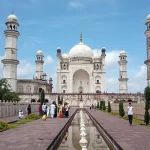
- Bhusawal – Maharashtra’s Hidden Gem of Culture and Commerce
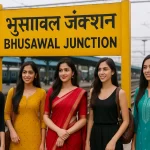
- Bharat Mata Temple, Daulatabad Fort – A Journey Through History & Spirituality
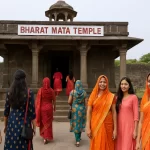
- Bhambavli Vajrai Waterfall, Satara, Maharashtra: India’s Natural Wonder

- Bhadra Maruti Temple Khuldabad, Chhatrapati Sambhaji Nagar (Aurangabad) – Divine History and Travel Guide
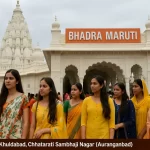
- Begusarai – Industrial Hub of Mithila Heritage

